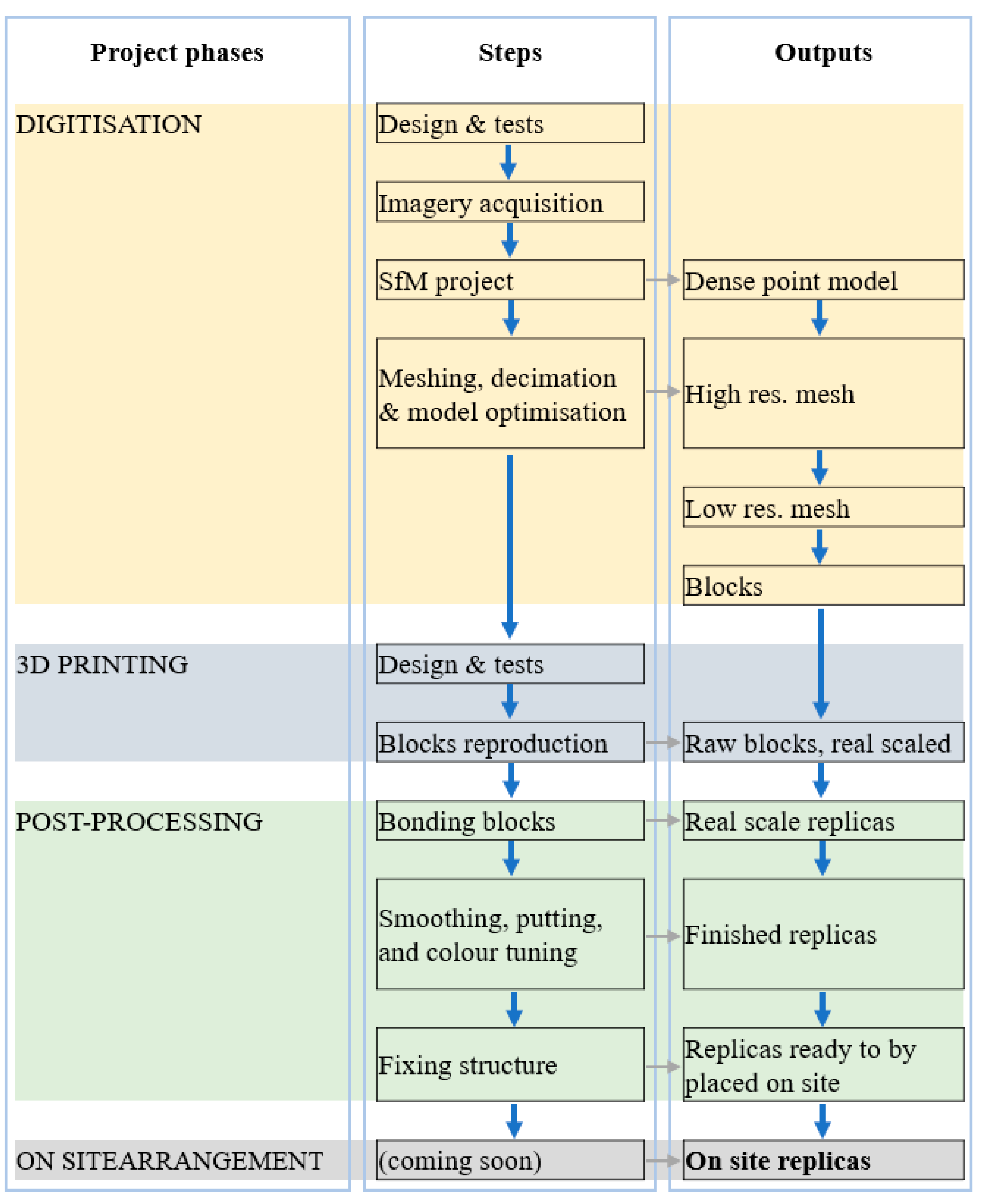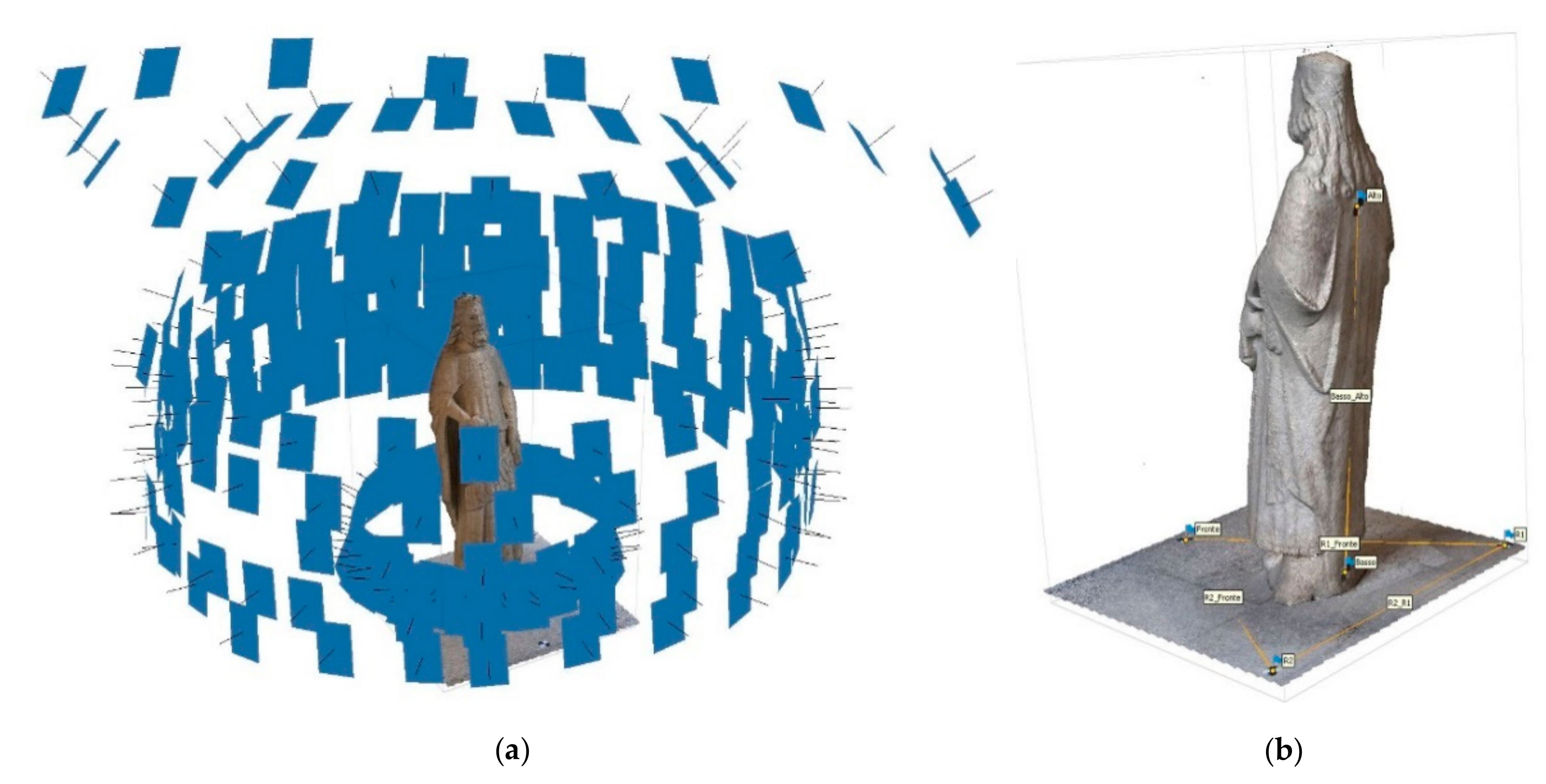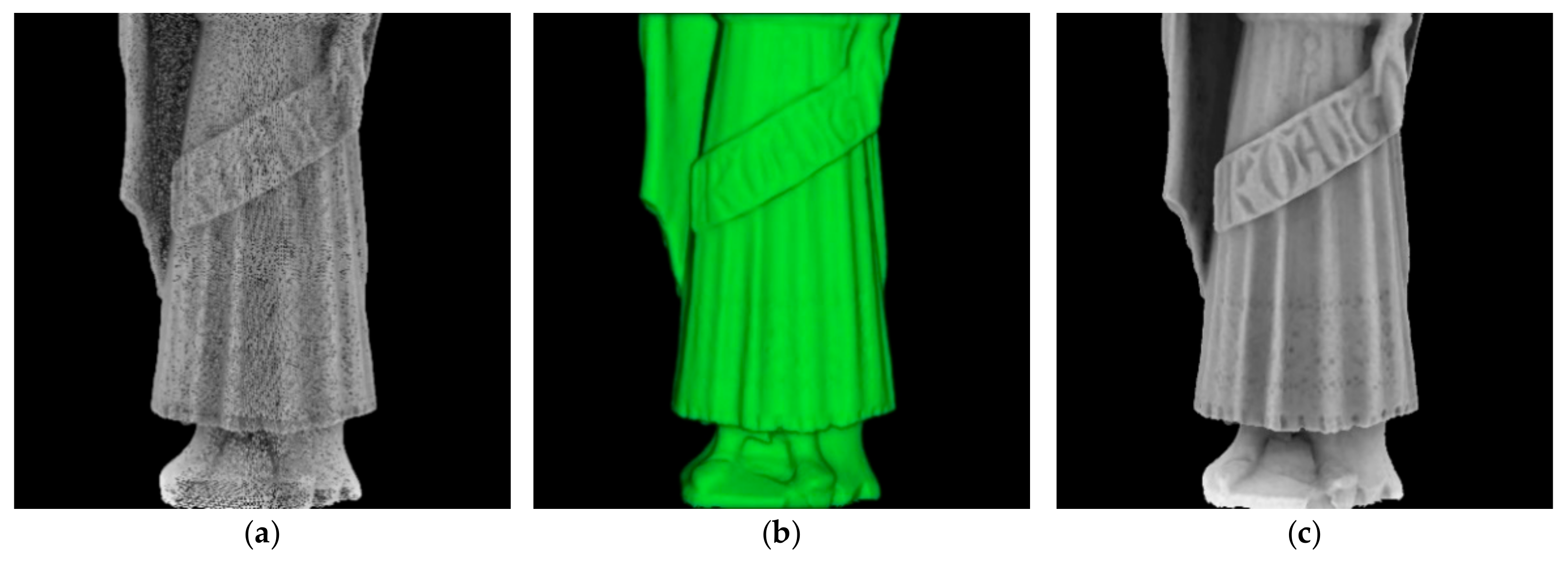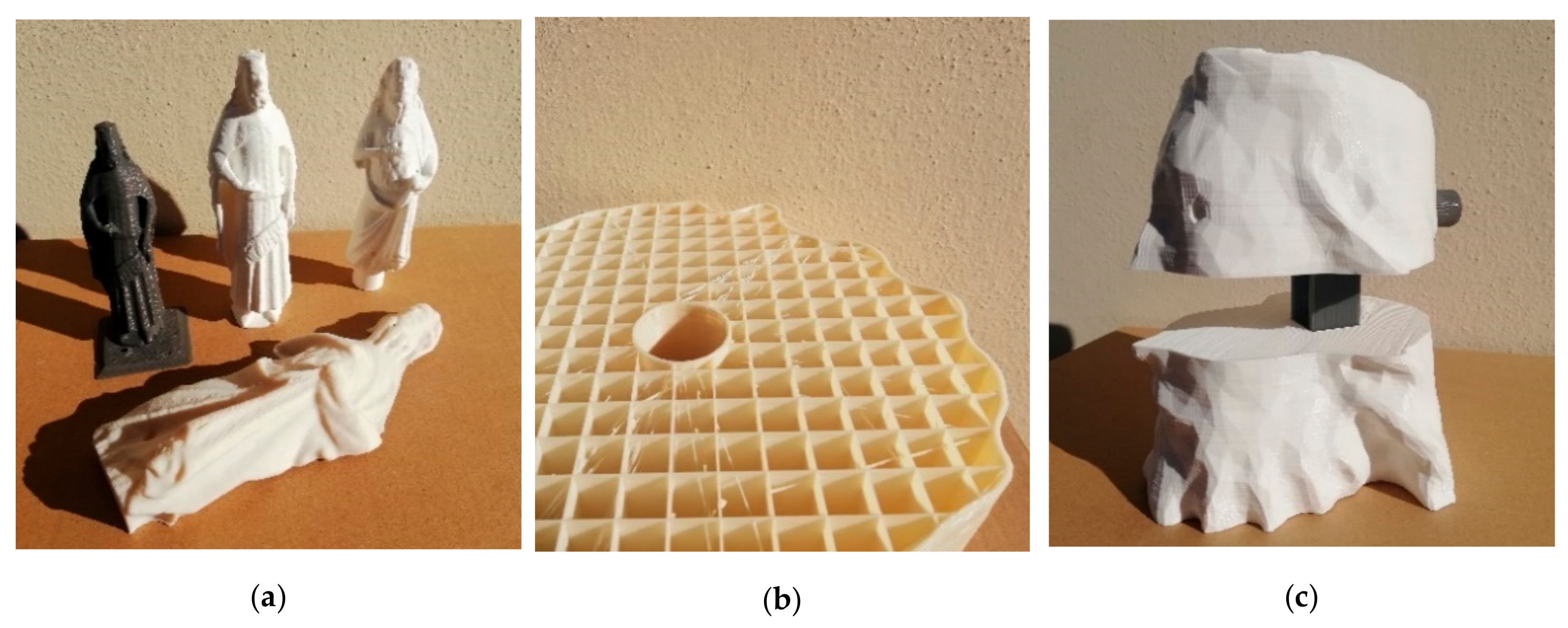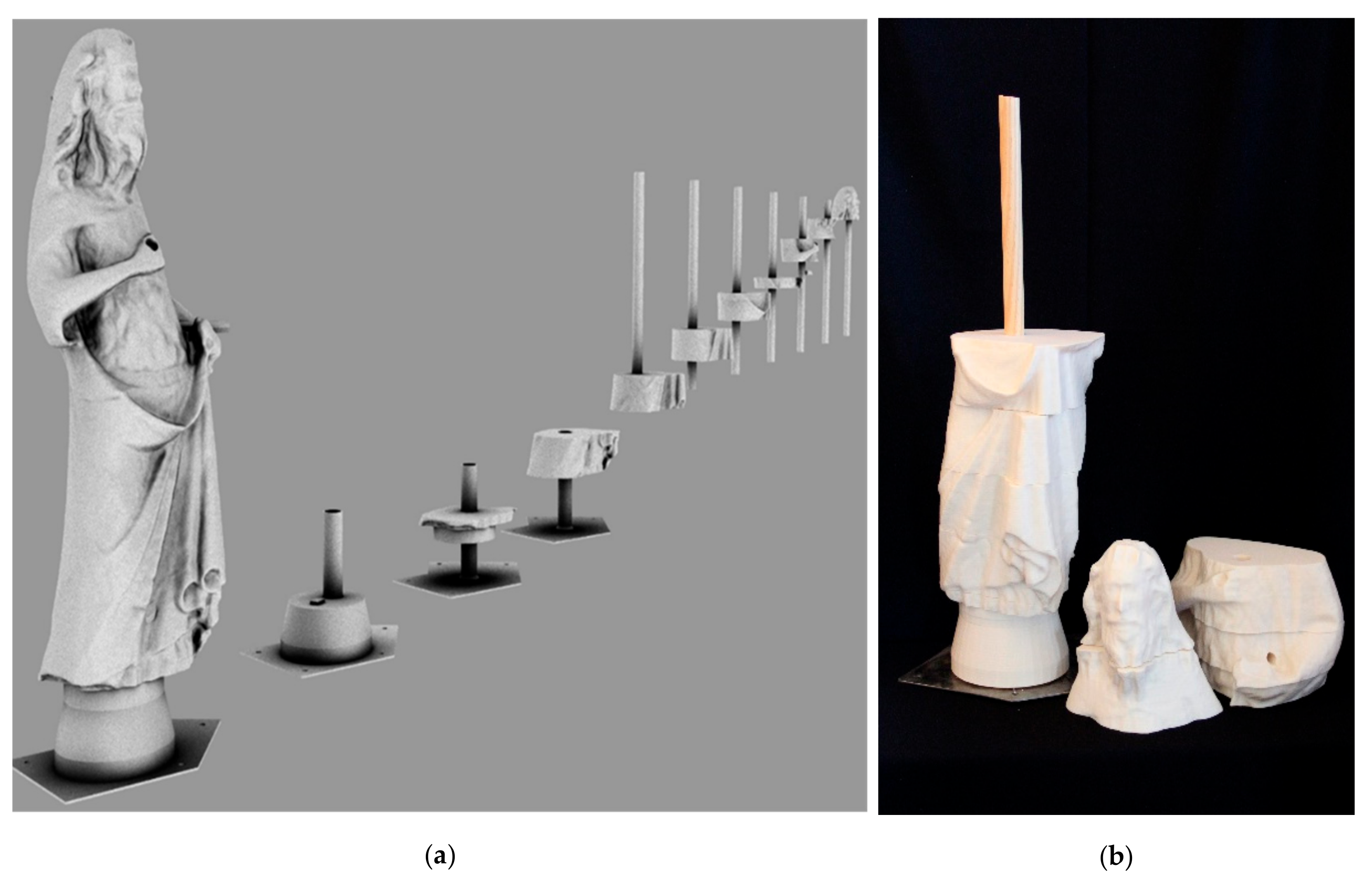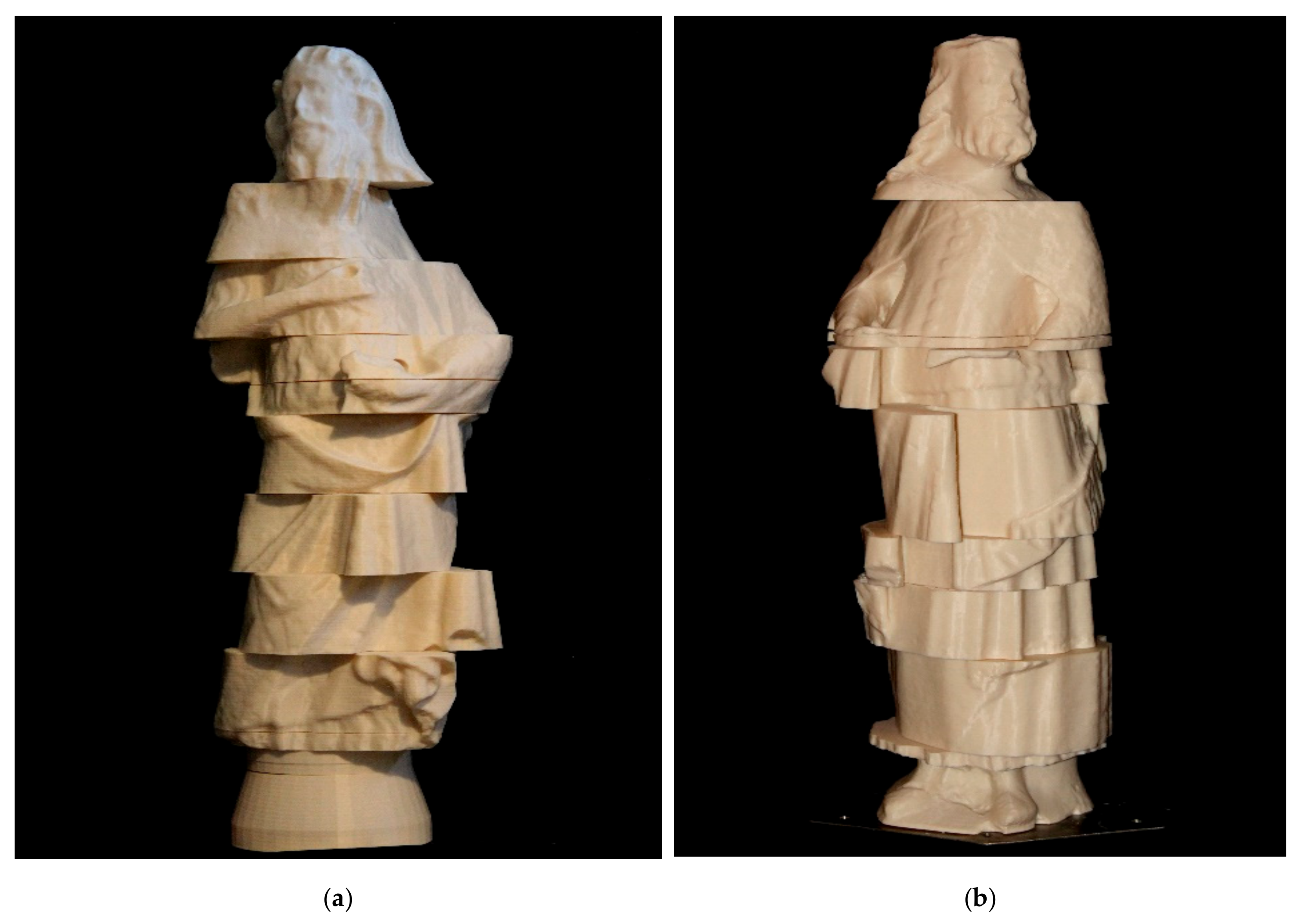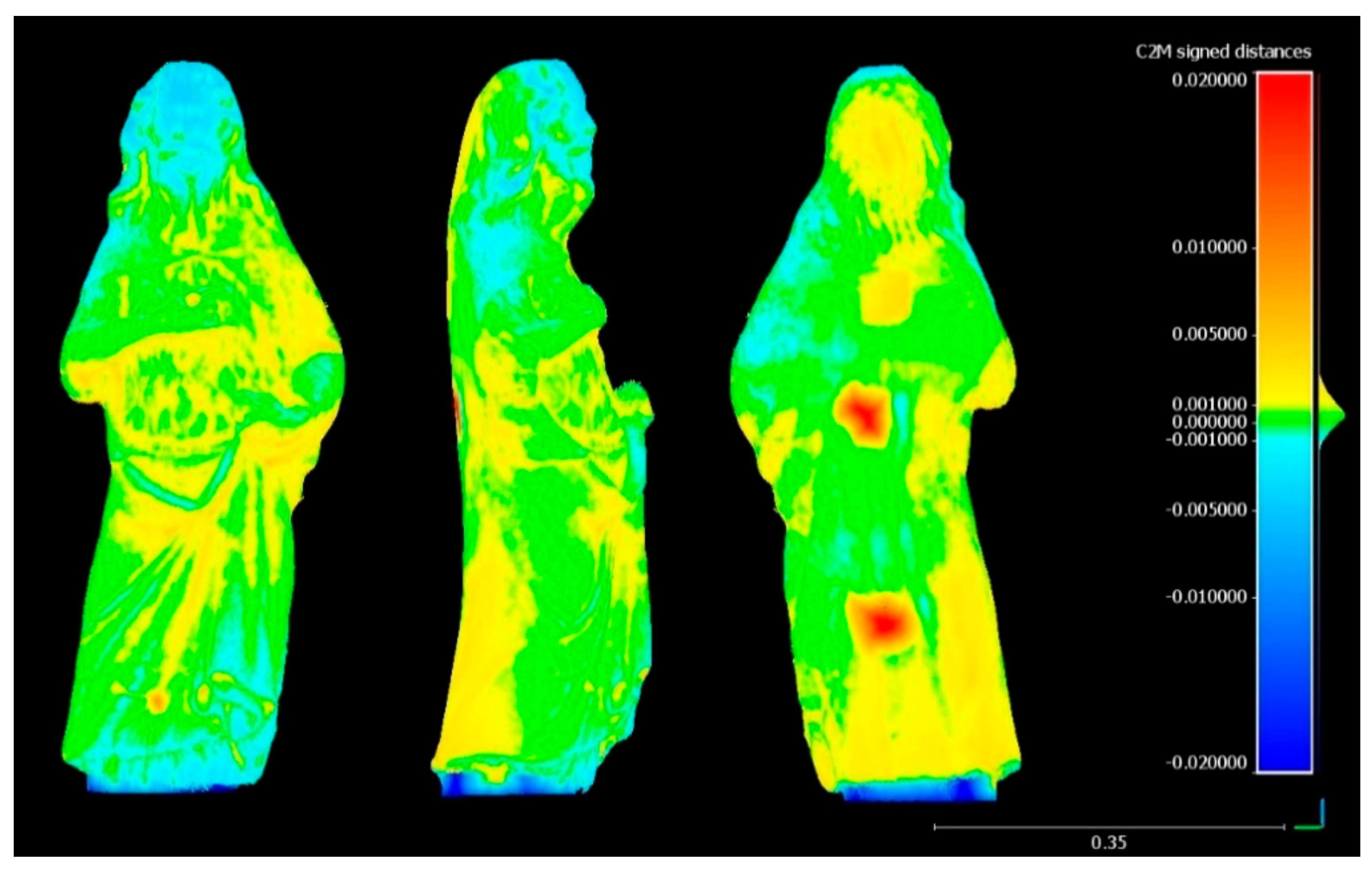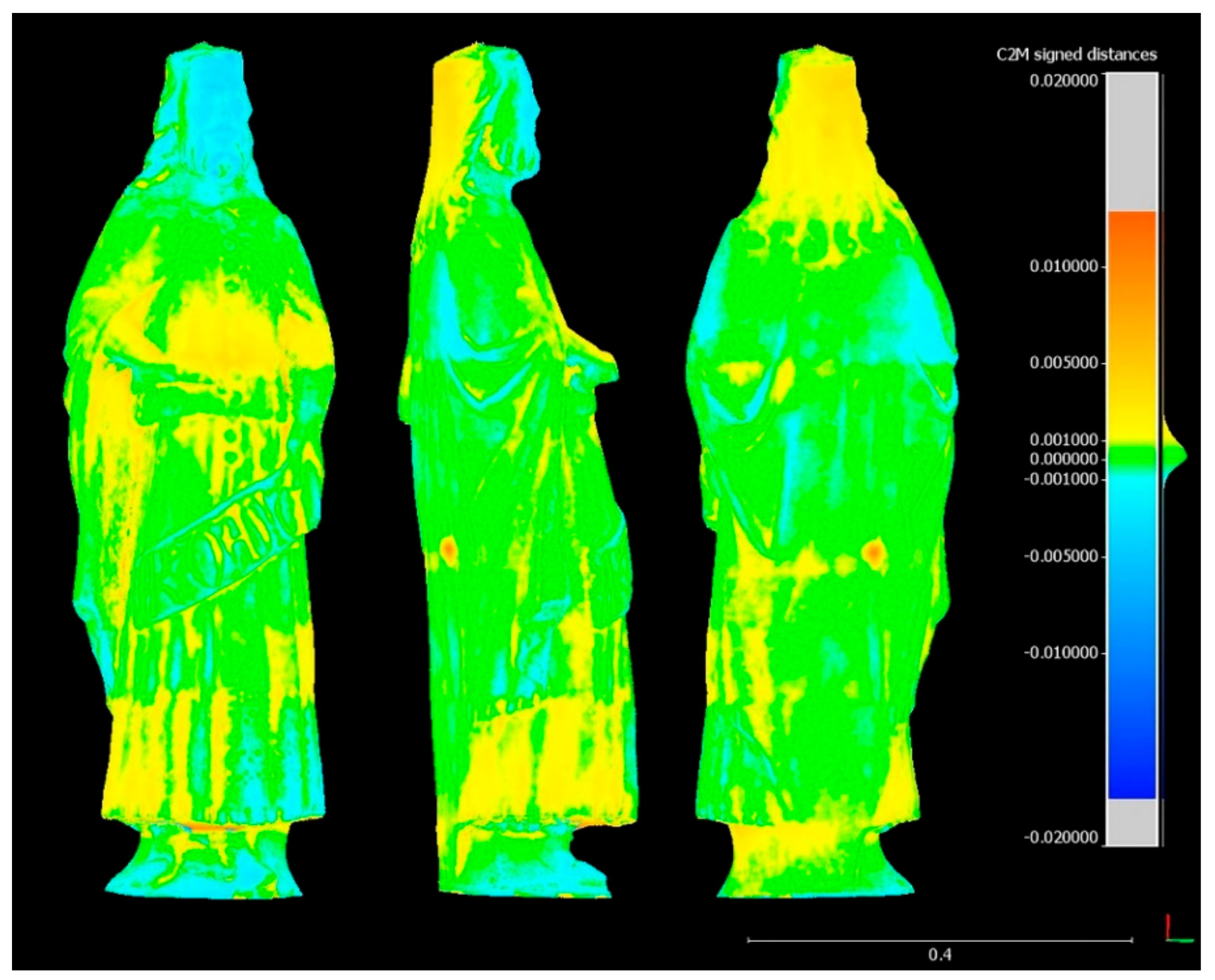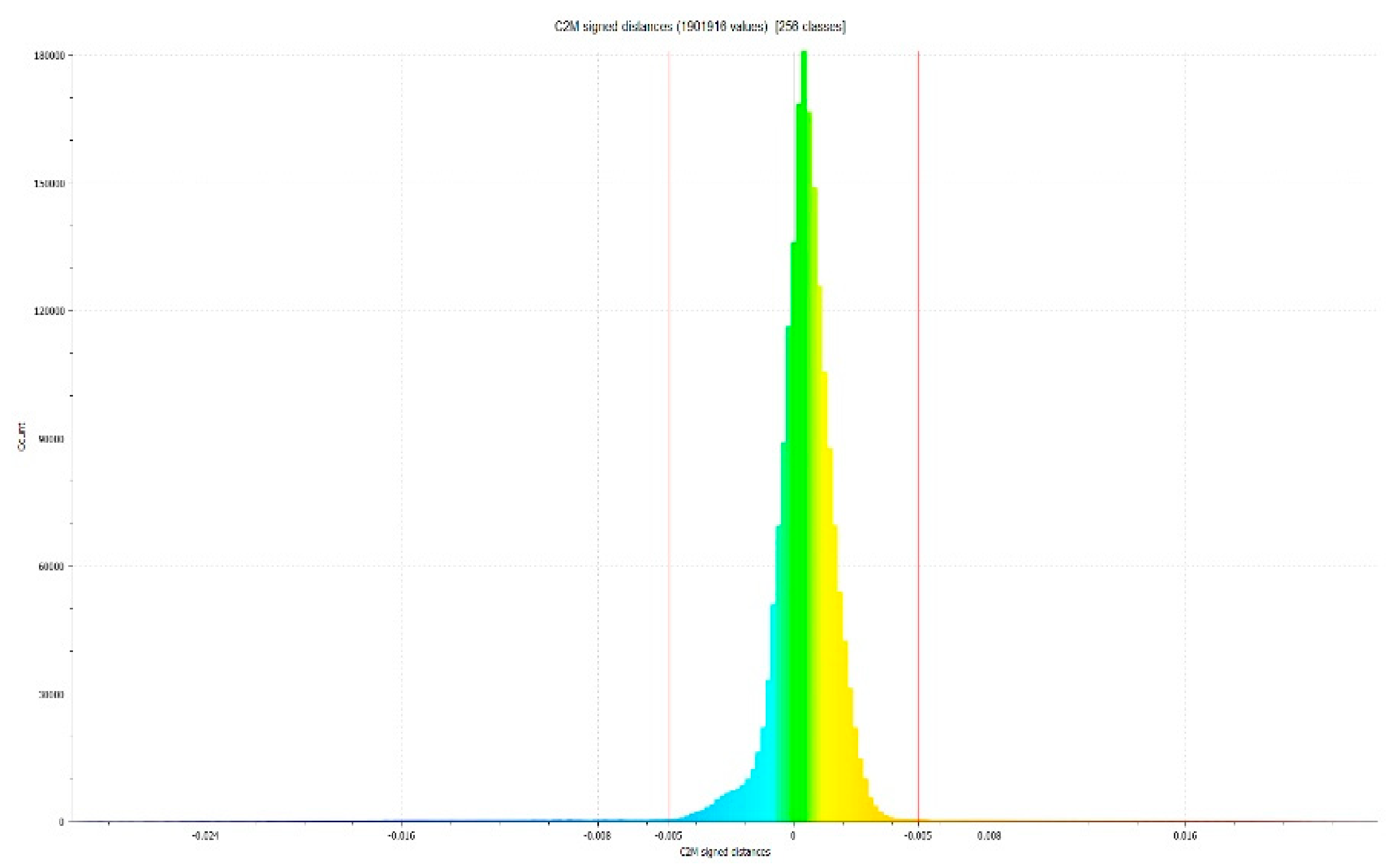1. Introduction
As the digital world continues to evolve, it is more relevant to avoid technological exercises instead of researching and providing new answers to improve our fragile heritage’s knowledge and conservation. What we called replicas in the past initially evolved into digital replicas and recently into digital twins. This neologism highlights the need to avoid sterile copies, to understand better the phenomena to which the built heritage is exposed, and to control its life cycle to activate sustainable interventions.
The primary purpose of the project presented here is the formation replicas of a couple of marble statues that have been removed from their original place in the Baptistry of San Giovanni in Corte in Pistoia, Italy (
Figure 1). The Superintendence consulted the Laboratory of Geomatics for environment and conservation of cultural heritage at the University of Florence, whose researchers have already had much experience with digital reproduction and tested different rapid prototyping techniques [
1,
2].
While several works report tests concerning rapid prototyping techniques for reproducing reduced-scale statues and other kinds of artifacts, or some relevant samples in full scale such as in [
3], this project presents a complete workflow for the digitization of the statues and the 3D printing and post-processing of their full-scale replicas that are going to substitute the originals on the baptistry.
Figure 2 summarizes the project workflow. All the steps of data elaboration and the outputs are also listed.
Some claim that we live in the age of the culture of the copy due to digital data’s pervasive presence in our everyday lives. Focusing on artifacts of artistic and historical interest, new technologies allow us to transform their real version into a digital copy through a digitization process (e.g., by laser scanning or photogrammetry) and then reproduce a solid copy with additive or subtractive manufacturing. Obviously, nobody would exchange the real object with its copy since specific differences between them (hopefully) persist. The concept of copying itself has changed its significance over time in parallel with the development of new copying techniques. The most relevant positive aspect of the wide availability of copies is that they help to spread knowledge about the original; “the copy leads us to the real” stated Rosmarie Beier-de Haan [
4], considering a Western (European) cultural approach.
The global coronavirus pandemic also has consequences for the enjoyment of cultural heritage, due to the limitations imposed on people’s travel and the closure of museums for long periods, but also the (further) limitations of specific resources that are expected in the near future. Like any crisis, however, it is also an opportunity to change one’s habits, try new things, and look for new solutions. Digital cultural heritage nowadays is contributing to people’s enjoyment and creativity more than ever. As reported by the International Council of Museums (ICOM) and by a survey collected by the Network of European Museum Organisations (NE-MO), most museums enhanced their digital activities through livestreaming events or online educational programs [
5,
6].
While most museums in the world are closed down physically, many of them explore digital tools as a means of capturing the attention of their audiences (e.g., by organizing specific events on social media and live streams).
Focusing on 3D content, museums explore remote engagement opportunities in different ways:
Virtual tours like those found on Google Arts & Culture [
7], which offers more than 2500 experiences similar to Street View in museums, palaces, and archaeological sites, among others. Other museums host their virtual visitors in a real 3D environment, such as the National Gallery of Art in Washington, with virtual exhibitions based on the Matterport system [
8];
Virtual and artificial reality projects that let users interact with and learn about the museum’s collection by using a headset and handheld controller, as in the home version of the virtual reality experience promoted by Musée du Louvre for
Mona Lisa: Beyond the Glass [
9];
Interactive 3D objects available to the public on the Internet. For example, the Smithsonian museum [
10] curators developed, over the course of more than ten years, a 3D program to digitize a relevant part of their impressive collections. 3D models can be explored on the museum’s website, on top of being able to take measurements and slicing and reading notes linked to models’ details. More recently, many other museums have started to work in this way, such as the Garstang Museum in Liverpool which, thanks to a photogrammetric team, digitizes several archaeological findings and publishes on their 3D models on Sketchfab [
11], thereby making them available to a wider portion of the public. The British Museum shares hundreds of 3D models on the same web-platform as well [
12].
The increasing availability of 3D models will probably make solid reproductions less episodic than they are now, further increasing the number of experts that must work together (e.g., photographers, digital imaging specialists, surveyors, art and architecture historians, 3D modelers, 3D printing experts, artisans for finishing surfaces, and museum curators).
To replicate small artifacts, a 3D printer using gypsum powder can be profitably used; the small drops of binder that solidify the powder can be colored to reproduce the geometry and texture of the original object at the same time. When a stronger model is required, it is more appropriate to use plastic filament extrusion systems (a wide variety of materials are available) or a sintering system. Milling machines are often reserved for large-scale reproductions, especially those with a low level of detail. Full-scale replicas of large volume objects that are not printable in one piece require the addressing of specific issues:
Design how to divide the model into parts to be reproduced individually;
Limit the deformation of individual parts;
Assembly, possibly also with internal support and a reinforcement structure;
Surface finishing and reconstruction of the original texture.
A further issue related to replicas that will replace outdoor original works is the choice of material, ensuring excellent open-air endurance.
3D replicas are not only interesting for improving engagement in museums, but also for research, documentation, and preservation. Due to the precarious state of conservation, some artifacts are sometimes removed from their original location and, once restored, kept in museums or protected places. Their removal results in significant damage to the image of the cultural heritage site that previously hosted them, and 3D replicas can be used to revive the image of the site to what it was.
They also offer a new point of view in the debate on how to intervene in architectural restoration while remembering that, in this case, it is not really a question of reintegrating lacunae, or at least that the lacunae we are talking about were not generated over time with the consequent loss of the original image, but by the urgent and contemporary need to safeguard certain elements of the monument itself, whose image can now be faithfully reproduced. They therefore allow a unified perception of the monument, ensuring at the same time the recognizability of the intervention and the preservation of the original.
2. Materials and Methods
The following section (
Section 2.1) illustrates how full-scale copies (i.e., replicas), realized by starting from a reality-based digital copy, can be profitably used in cultural heritage preservation projects.
Section 2.2 presents a couple of marble statues that were replicated to preserve the originals and bring back the aspect of the baptistry which they were initially placed. Then, the digitization process is described (
Section 2.3).
2.1. 3D Printing Uses in Cultural Heritage Preservation
A replica is a copy closely resembling the shape and appearance of the original object. 3D printing techniques allow for producing objective replicas, unlike what happens with a craftsman’s reproduction, which inevitably introduces some subjective interpretation, even though ingenious tools have always been used to provide stonecutters and sculptors with accurate geometric references. Moreover, a handcrafted copy makes use of tools, methods, and materials similar to those used in the production of the original object.
In Italy, the fabricerie and opere are institutions that provide for the conservation of primary religious buildings, carrying out continuous maintenance interventions. In many cases, when it is no longer possible to restore certain structural or decorative elements, they replace them with copies [
13], as the Fabbrica del Duomo di Milano does [
14], supported in recent years by a geomatic team for reality-based 3D modeling [
15] (
Figure 3).
Alongside these traditional ways of reproducing artistic elements, the spread of additive manufacturing systems has opened up new perspectives [
17]. Numerous experiences have led to creating small-scale copies mainly for exhibitive and educational purposes. Digital archives, such as those of the digital library Europeana [
18], are available to support these projects, and many other models can be found on platforms such as Sketchfab [
19]. This work refers instead to the specific challenges that arise from full-scale reproductions of artistic artifacts of such a size that they cannot generally be printed in a single piece.
Below is a list of some application areas that can benefit from full-scale copying by digital fabrication techniques:
The integration of missing or broken areas of artifacts or architectural components, as described by Bigliardi et al. [
20], for the integration of some missing parts in a cornice in the Ducal Palace in Mantua;
The production of a highly accurate shell for reducing the risk of damage to heritage artifacts during shipping. Fatuzzo et al. [
21] produced sculpture and packaging prototypes by additive manufacturing for aesthetic, functional, and assembly evaluations of the packaging. Asla et al. [
22] 3D printed 3D-fitted containers for packaging heritage artifacts which fit the artifact tightly;
Making molds for reproductions in other materials. The replica of the northern door of the Baptistry in Florence started from 3D-printed copies of the original, on which the silicone was poured. Then, the wax reproduction was made and, after chiseling work to add small details, the plaster mold was made on the wax and lastly completed with the bronze casting. The reproduction of one of the ceramic putti of the Innocenti Hospital in Florence also followed a similar workflow: the model was initially milled from polystyrene, and then the plaster molds and the final ceramic replica were made [
23];
New modes of interaction between the public and collections in exhibitions and museums, particularly supporting and enhancing the fruition of artworks by people with learning difficulties and children, as well as visually impaired and blind people [
24,
25];
The reintegration or reconstruction of a plausible appearance of lost or partially lost objects, as we did for a missing part of a female figure in the frieze of the Spedale del Ceppo in Pistoia [
25] or as reported by Neumuller for the ceramic lion originally in the temple of the ancient city of Nuzi (modern-day Iraq) [
24];
Spreading knowledge within museums, archives, and other institutes [
26,
27];
Improving public engagement and awareness about cultural heritage at risk, as the Institute for Digital Archaeology did in 2015 by printing and assembling a copy of the arch of the Temple of Bel in Palmyra’s ancient city, which was destroyed by ISIS [
28].
2.2. The Statues
The original statues were placed on the pilasters framing the facade of the Baptistery of Pistoia; they were removed from there in the mid-1980s to safeguard their integrity. Both showed evident signs of deterioration due to the actions of atmospheric agents. At present, they are stored with others ornamental stones coming from the Baptistry and the Cathedral in the rectory of San Zeno in Pistoia. The statues, detailed below, are both marble, and they are less than one meter tall:
St. Johan the Baptist represents the saint in his classical iconography, with a beard and long hair and dressed in camel hair. It is, of the two, the one in worse condition; its feet are missing, and a plaster base currently supports it;
The iconography of the second statue presents some attribution issues. Someone proposed it to be St. Johan the Evangelist. Others identify a prophet or St. Jacopo, patron saint of the city, wearing its cloak and holding up the titulus.
They were both sculpted within the end of the fourteenth century, when work for building the baptistry and its marble covering finished (
Figure 1).
2.3. The Digital Replicas
High-resolution 3D models are required for supporting the replica process. They can be obtained by range-based techniques (active sensors) or image-based techniques (passive sensors). Stanco and Tanasi reported on the use of a Nextengine laser scanner for the digital replica of a marble statue of the god Asclepius [
29]. Skarlatos et al. tested optical and laser systems on the same object, discussing the pros and cons of both [
30].
3D digital models were made in this project by a structure from motion (SfM) system, allowing us to quickly and automatically reconstruct the surfaces and offering, at the same time, excellent overall accuracy.
The specific issues that were faced during data acquisition were related to the following:
Organizing a set for taking photos in the place where the statues were stored;
Finding the best camera settings and updating them accordingly for weather (and light) conditions;
Defining a reference frame for metrically controlling the 3D model.
A room with big windows only on one side was the place available for the survey (
Figure 4). The statues, initially stored next to a wall, were moved to the middle of the room. A D700 camera (by Nikon) was used for acquiring the imagery, being set up with a 50 mm lens, an ISO speed of 800 and an aperture of f/14 after checking to achieve a sufficiently large depth of field. Considering the exposure time, generally longer than half a second, a tripod and timed shooting were used.
To ensure a regular camera network, some references were marked on the ground at a distance of about 1 m from the statues for acquiring 16 photos spaced regularly all around the object, starting from a height of 20 cm from the ground and increasing the tripod height by 20 cm for each strip (
Figure 5). Additional photos were taken by hand, framing some statue details in their most complex parts and also tilting the camera clockwise and counter-clockwise to improve camera calibration.
Two hundred thirty-one photos were taken of the St. Johan the Baptist statue, and 284 were taken of the St. Jacopo statue. Always pointing the camera at the statue ensured a high overlap. A check of the photo’s quality was performed manually, and some color and exposure enhancement was done while developing the raw files (recorded initially in NEF format).
Small black and white targets were placed on the ground (for St. Jacopo) or on the base of the statue (in the case of St. Johan the Baptist), and a couple of them were temporarily glued on the back of the statues to define a known distance that was almost vertical and out of the supporting plane. Mutual distances were measured by a tape measure, with an expected accuracy of about 1 mm.
The SfM projects were carried out in Photoscan software [
31] (by Agisoft), which allowed tuning of some parameters ruling data elaboration, particularly the following:
The accuracy parameter in the align photos step was set to high, meaning that it was considering the original resolution of the photos (no downscaling occurred) for tie points recognition and matching;
The quality parameter in the dense cloud building step was set to high, which implied a downscaling of the images by a factor of four for the dense matching process;
Lastly, deep filtering was set to aggressive to sort out most of the outliers.
In the case of movable artifacts, as the statues were, there was no need to fix an external reference system, and referencing issues of the object could be disregarded, while it was fundamental to scale the model correctly. For this purpose, redundant scale bars with reference distances were introduced, and their residuals after the optimization process were assumed as an indicator of the model’s accuracy. The root-mean-square deviationof the scale bars was ±1.5 mm in the St. Johan the Baptist project and lower than ±1 mm in the St. Jacopo project.
The appearance of the point-based models was good, with very few and small absences of data and textures with good color quality. Some slightly noisy data corresponded to the more shaded areas, due to the complex shapes of some parts of the statues. The meshing process output models made by about 3.8 million triangles (St. Johan the Baptist) and about 2.5 million triangles (St. Jacopo). The quality of these digital replicas was good, but some more processing steps were required before 3D printing. Small holes were closed, and some topological issues were solved in the undercut parts, such as at the bottom of the garment and behind the right arm of the St. Jacopo statue.
A strong decimation should entail a loss of details. At the same time, reduced numbers of polygons were required to manage the 3D model in the slicer software and to prepare it for printing. Therefore, different levels of decimation were tested before reaching the desired result, according to the maximum file size that was possible to process in the following step. Rendering techniques allow for balancing the loss of geometry, producing impressive views of low-resolution 3D models.
Figure 6 compares the shaded view of a detail on a decimated mesh with an ambient occlusion render (computed in CloudCompare by the PCV plugin, initially developed by Tarini et al. [
32]).
Obviously, the 3D-printed models’ resolutions could not be improved through visual simulations. Actually, it must be considered a loss of detail due to the staircase effect; the thinner the layer of the employed material is, the better the appearance of the model is preserved.
3. Results
The 3D-Printed Replicas
A variety of 3D printing systems are currently available and are based on different technologies, such as deposition techniques, sintering strategies, and other approaches. Different kinds of materials can be used as well.
The specific issues of this project were mainly related to the need for printing large-volume objects and ensuring excellent open-air endurance. Therefore, we choose a fused deposition modeling (FDM) 3D printer, in which a heat-resistant filament made of plastic was heated up to temperatures of 200–250 °C and then passed through a nozzle which, guided by a mechanical arm, deposited the following layers to give shape to the object.
A 300 h 3D printer (by Kloner 3D) [
33] was used to produce the replicas. It allowed for printing a volume of 320 mm × 260 mm × 330 mm, which is a very large volume for this category of printers.
The print area on the horizontal plane was large enough to encompass all the horizontal sections of both statues, even if it was necessary to partition them in blocks about 20 cm high, as is better described later.
Since the reproductions must be exposed to atmospheric agents, the most appropriate material for their printing was carefully selected: a filament called acrylonitrile styrene acrylate (ASA). This was chosen because it is produced to withstand considerable temperature ranges, ensuring stability in sunlight and adequate mechanical qualities. Its version without added pigments was used, offering an ideal base for the subsequent processing steps.
Both models were edited, capping the bases to obtain watertight surfaces, and a series of reduced scale prints of the complete statues were made. Then, some full-size elements were printed to evaluate possible work problems and the final appearance.
To limit the printing time to a maximum of 48 h [
34] (and contain the risk of print failure), both statues were segmented into blocks by horizontal cutting planes.
Each block was individually imported into the 3D printer management software to compute the slicing and to evaluate the fundamental parameters of the printing, which were as follows:
Thick layers avoid delamination issues, but also increase the staircase effect. To balance the resistance needs with the appearance requirements, after some tests, the height of the layers was set to 0.3 mm.
The external surface plays a structural role, and it is simultaneously the supporting material for post-printing finishing operations. It was set to 1.8 mm.
The infill structure is defined as a percentage of the inner volume of the model. The denser the filling is, the more resistant the pattern is, but at the same time, more material and a longer printing time are needed. To balance all these aspects, the infill was set as 10% of the volume.
Figure 7 and
Figure 8 show some of the printing tests.
The cutting plane position was designed by considering both the printing time and the shapes of the resulting blocks, avoiding printing supports, which are essential to work with overhanging parts, but obviously require extra material and finishing procedures for their removal (
Figure 9 and
Figure 10). The sections to be managed with more attention have proven to be those in the area of the forearms and elbows because they have the most pronounced overhangs and, in the case of St. Jacopo, even the largest undercuts.
During the restoration works, two steel plates were fixed on the crowning of the Baptistery where the replicas would be placed. Each of the statues had a corresponding steel flange, to which a vertical tube was welded. All the printed blocks had a hole for letting it cross all of the model, support the replica, and fix it to the support (
Figure 9). In the replica of St. Johan the Baptist, the tube was vertical, while the posture of the St. Jacopo statue required designing the support and blending it toward the rear, starting from the second block. In both cases, small holes were left in the printed parts for inserting some mechanical fixings. Since all of the process was performed on the digital model, it was also possible to design caps with a shape perfectly fitting the holes and completely hiding the fixing system.
Expert restorers glued the blocks of every statue with special resin and plastered their junctions. Finally, they treated the external surface to obtain a homogeneous color tone close to that of the building’s facade.
4. Discussion
This project allowed us to assess the potential of reality-based 3D models and FDM printing systems in a considerable case study. All the phases proposed specific challenges, generally closely related to the particular context. Here, we list them and present how, when it was possible, we solved them.
Section 4.1 focuses on digital model production by SfM,
Section 4.2 discusses the 3D printing and finishing process, and
Section 4.3 assesses the metric accuracy of the replicas.
4.1. Reality-Based Digital Model Production
The main concern during the digitization process was the location available for the survey. Unfortunately, we had no option to move the originals from their site or to manage the light coming from a glass wall on the side of the room in a better way; as is quite common while working with artifacts of such size and weight, they were not easy to safely move (
Figure 4). Therefore, we balanced some differences in image exposures before proceeding with the SfM project. Considering the point model we obtained, some noisy points and a lack of data were evident in the lower part of the statues. This was due to the impossibility of taking more pictures from low points of view (or of lifting the statues for the shoot). The camera was placed as low as possible on the tripod. We could have turned around, taking photos even with the camera resting on the ground, although this was not convenient to verify the framing.
The original statue of St. John the Baptist is missing the lower part, and a plaster base supports it. In the copy, a truncated cone support was digitally modeled so as to position the saint’s body at a correct height.
4.2. Replica Production
In order to keep the cost of making replicas as low as possible, the two parameters to be controlled were the quantity of the material used and the time needed for printing. Obviously, optimization of the printing process must not compromise the quality of the final result.
As described before, the size of the original did not allow reproduction in a single piece. The size and shape of the printing blocks required careful design. In particular, to contain the amount of material used and avoid the creation of supports, some pieces were printed upside down.
Test prints highlighted that some blocks (the ones with wide bases of contact with the printer plane) were very difficult to remove without applying force directly on the edges. Therefore, a kind of raft was used; it was a horizontal mesh of filament deposited directly on the build platform, on which the first layer of the actual print was deposited. The raft was also useful for keeping the print grounded to the build platform, containing a warping effect. Warping occurs due to material shrinkage. During the printing, the plastic firstly expands slightly, but it contracts as it cools down. Curled top and bottom surfaces complicate the assembly of adjacent blocks. In our case, the unevenness of the adjacent faces was negligible, and the finishing phase of the replicas rejoined any small spaces.
Several tests were necessary to identify the most appropriate operating methods and products for finishing the replicas. The printed blocks were glued together and, for the support that crossed them, the joints were filled, the staircase effect was removed with light sandblasting, and the chromatic homogeneity was recreated with a final surface treatment (
Figure 11).
The characteristics of the materials available today for 3D printers have seldom been analyzed to prove their suitability for use in restoration works in terms of reversibility, compatibility, and durability. To date, few experiences are known in the literature about the application of 3D printing to integrate or substitute artifacts in restoration projects, as discussed in [
26,
35]. Materials for 3D printing are continuously developing, but unfortunately, the research is more oriented toward the mechanical field than the historical artistic one. Outdoor conservation of the replicas can only be evaluated after a certain period.
In addition to the strength of the material, the stability of the installation of the replicas was one of the aspects carefully assessed and required the design of a special system for anchoring to the crowning element of the baptistry (
Figure 9).
4.3. How Close Are the Replicas to the Originals?
One can evaluate the replicas’ accuracy only with respect to the models that were digitized from the original statues, which in turn were affected by a metric uncertainty that, as reported in
Section 2.3, could be assessed thanks to the redundant distances (scale bars) that were considered during the SfM computation, being an RMSE of about ±1.5 mm in both projects. A check of the reliability of 3D-printed small artifacts is described in [
36].
Other factors influencing the faithfulness of the replicas are related to the technical characteristics of the 3D printer, print settings, block assembly operations, and lastly the surface finishing treatments.
No standardized procedures are established to define the accuracy of a 3D printer, and this is generally an indication that is missing from the datasheets. However, the printing settings determine the quality (also from a metric point of view) of the final result. Instead, the nozzle diameter (in planimetry) and the thickness of the layer (in elevation) can be used as reference values for the resolution.
The Kloner 300 h 3D printer has a nozzle diameter of 0.5 mm. For our project, the height of the layers was set to 0.3 mm. As described before, some dimensional variations were expected in the printed blocks due to thermal effects. Moreover, the gluing of the blocks and, above all, the surface finishing phase, could have introduced further variations with respect to the shape of the digital model.
In order to globally evaluate any deformations that may have occurred during the entire process of making the solid model, the photogrammetric survey of the replicas was repeated at the end of the project (
Figure 12), and the distance between the 3D models of the real statues and that of their replicas were computed to assess the 3D printing process from a metric point of view.
To obtain differences between two 3D models, most algorithms are based on geometric measurements of the distance or curvature [
37,
38,
39,
40]. The Hausdorff distance [
41] computation is implemented in the CloudCompare open-source software [
42]. Actually, the set of distances computed for every point is considered here without computing the maximum distance out of it, as one would do with the real Hausdorff distance. It is therefore suitable for shape comparisons, since it is calculated between each point of the compared model (the point cloud model of the replicas) and the nearest triangle of the reference model (the mesh model of the real statues). The surface models produced by the photogrammetric survey of the original statues were adopted as references, considering the mesh as a more robust surface representation with respect to the noise. Indeed, meshes have intrinsic information on the orientation of triangles’ normals that is used to determine what is inside or outside of the mesh itself, allowing us to compute signed distances. After hiding the reference mesh, the resulting distances are displayed on the compared cloud through a color palette. The color tends to be blue (negative values) if the replica is inside the original and red (positive values) if it is protruding more than the original.
Before the distance calculation, the meshes were cleaned, and points outside the examined space were roughly eliminated from the point cloud.
Figure 13 and
Figure 14 show the differences for the statue of St. Johan the Baptist and the statue of St. Jacopo. Most of the distances were included in values around +/−1 mm, with minimum and maximum values of −1.7 cm and +1.2 cm, respectively, for the statue of St. Jacopo and around −2.9 cm and +2.3 cm, respectively, for the statue of St. Johan the Baptist. The color scale ranged +/−2 cm for both cases, even if the data of St. Jacopo did not cover the whole range. Therefore, the higher and lower values were due to the following:
The less accurate photogrammetric model of the undercuts in the lower part of the statue, since it was difficult to frame those areas with the camera;
The presence of rear holes, used in the past for fixing original statues on top of the baptistry pilasters, that were filled in the replicas.
The histogram of distances (
Figure 15) shows that the great majority of the data is included in a narrow interval close to zero and is slightly asymmetrical; a very low amount of data showed long queues to the extreme. Aiming therefore to discard these values due to the diversity of the geometries compared, as stated before, the color scale range was reduced from +/− 2 cm to +/− 5 mm. The analysis of a great majority of the data is still possible, and differences between the datasets are rendered more evident (
Figure 16 and
Figure 17).
In the case of St. Jacopo, the horizontal cutting planes between the blocks of the replica are clearly visible, and the head especially is translated toward the back with respect to the original, as demonstrated by the negative distances in the face and positive distances in the nape (
Figure 17). In the case of St. Johan the Baptist, the sequence of horizontal cutting planes is less visible, but the block of the head, as in the previous case, is translated toward the back (
Figure 16).
Both replicas present a deviation in the order of 1–3 mm on the lower part. It is noticeable on St. Jacopo above the belt and on St. Johan the Baptist under the drapery of the cloak and under the arms. Conversely, in the upper parts (such as shoulders, the upper part of the drapery, and the upper part of the titulus), the deviations have negative values, thus determining a deficiency of the replica compared to the original.
In summation, the differences between the originals and the replicas can be traced back to the following:
The 3D-printed block assembly, since it is possible to notice their horizontal cutting planes (in the bodies) and a kind of rotation (of the heads);
A smooth effect that implies a loss in surface details, probably related to the final treatment of the replicas.
Disregarding more relevant changes in the lower support of the St. Johan the Baptist statue and in parts where the holes have been filled, the faithfulness of the replicas is absolutely satisfactory from a metric point of view.
5. Conclusions
The project described allowed us to assess the potential of reality-based 3D models and FDM printing systems in a valuable case study, while also offering an interesting opportunity for the interaction of different disciplines. When the project started, all the experts involved were not so sure about the results they would gain. All of them were very well-versed in their fields of study, but it was not the same for the others. The very idea of a best resolution, satisfying visual aspect, or work done in quick time was interpreted differently by experts in different disciplines and required thoughtful and open dialogue to identify feasible, functional, efficient, and effective solutions.
SfM was applied to digitize the original statues and their replicas as well. The former models were used to support the 3D printing process, and later they were compared with the replicas’ models to assess their accuracy. From a metric point of view, they ended up closely corresponding to the original. The treatment they received also make their appearances truthful.
No standardized procedures are established to define the accuracy of a 3D printer, and this is generally an indication that is missing from the datasheets. However, the printing settings affect the quality (also from a metric point of view) of the final result. Instead, the nozzle diameter (in planimetry) and the thickness of the layer (in elevation) can be used as reference values for the resolution. Some dimensional variations are expected in the printed blocks due to thermal effects. Moreover, the gluing of the blocks and, above all, the surface finishing phase, could have introduced further variations with respect to the shape of the digital model.
In conclusion, the ability to capture detailed three-dimensional data and to exploit additive manufacturing techniques opens up several options for restorers interested in material preservation as well as preserving the concept of authenticity. Digital copies and 3D-printed objects inspire new thoughts about the ideas of image and matter preservation and integration and the substitution of original works.

